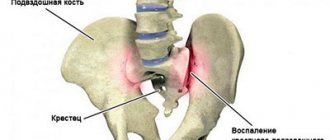Causes of chilly hands
Physiological factors
Coldness of the upper extremities is often observed in older people, which is associated with impaired peripheral circulation and spasm of small vessels. Patients complain that their hands are constantly cold and the sensitivity of their fingers worsens. The symptom sometimes occurs in women with constitutional hypotension or emotional stress. In this case, vascular spasm occurs, blood flow to the distal parts of the limbs decreases.
Frostbite
Even after mild grade 1-2 damage to the skin, increased sensitivity of the hands to low temperatures persists for a long time. Chilliness with an unpleasant tingling sensation appears when a person washes his hands in cold water or goes outside in winter without gloves. Even in a warm room, discomfort is periodically felt; the hands remain cold. Under the influence of cold, numbness and paresthesia of the fingers usually occur, after which the hands do not warm up for a long time.
Raynaud's syndrome
At the onset of the disease, patients suffer from rare bouts of chilliness, observed during times of stress or exposure to low temperatures. The tips of the fingers suddenly turn pale, become milky white, and there is a feeling of numbness and goosebumps crawling on the skin. The paroxysm is short-lived, after its end the chilliness is replaced by an unpleasant burning sensation, a feeling of heat and redness of the fingers.
As Raynaud's syndrome progresses, attacks of arm ischemia lengthen to 1 hour. They begin without visible provoking factors and are accompanied by severe chilliness, pain, and loss of sensitivity in the hands. During the interictal period, the fingers are almost constantly cold, the patient experiences discomfort and pain in the hands when exposed to low temperatures. Over time, swelling, trophic ulcers, and deformations of the nail plates occur.
Cold hands
Vibration disease
Vibration disease develops in workers who are constantly in contact with impact or rotational mechanisms. Coldness of the hands manifests itself during periods of rest or at night, combined with paresthesia and nagging pain. At first, the symptoms last 10-15 minutes, but gradually the attacks lengthen, disturbances in active movements of the fingers appear, and sensitivity decreases.
Vegetative-vascular dystonia
In young people, chilliness of the hands and feet is often associated with disorders of the autonomic innervation. Patients with VSD note that the skin of the distal extremities is constantly cold to the touch and does not warm up well in warm rooms. Severe chilliness bothers a person on the street in the autumn-winter period - even in thick gloves or mittens one feels cold, paresthesia and an unpleasant tingling of the fingers.
Carpal tunnel syndrome
Chilliness, numbness, and paresthesia caused by compression of nerve fibers in the wrist area most often develop as an occupational disease—in musicians, packers, and people who work at a computer. The fingers are constantly cold, especially after a long working day, when the hands are in one position. Carpal tunnel syndrome causes periodic pain, decreased sensitivity, and difficulty bending and straightening the fingers.
Hypothyroidism
A decrease in the functional activity of the thyroid gland is accompanied by disturbances in thermoregulation. Patients with hypothyroidism are constantly cold, their skin becomes dry and cold to the touch. The most pronounced symptoms are in the area of the hands, which are not covered by clothing and are more likely to experience temperature changes. The chilliness does not go away even with massage, rubbing or warming the hands with a special heating pad.
Osteochondrosis
If the pathology affects the thoracic vertebrae, the innervation of the upper limbs is disrupted, which causes chilliness. The person also experiences intense back pain, which can radiate to the arm. Symptoms of osteochondrosis intensify with prolonged stay in an uncomfortable position, monotonous work, awkward turns and bends of the body.
Rare causes
- Lack of nutrients
: low-calorie diets, vitamin deficiency, disorders of digestion and absorption of food. - Neurological diseases
: radial nerve neuropathy, multiple sclerosis, acute cerebrovascular accidents. - Autoimmune processes
: scleroderma, systemic lupus erythematosus, periarteritis.
Forms of capsulitis and stages of development
| Inflammation of the ligamentous-tendon apparatus of the shoulder joint has two forms: | |
| Post-traumatic | Idiopathic (adhesive) |
| It occurs as a result of bone fractures, tendon ruptures, other injuries or surgical interventions in the shoulder area, when limited mobility is natural. The pathological process in this case develops as a result of insufficient or ineffective restorative therapy. | The problem arises spontaneously, developing against the background of various pathologies of non-traumatic origin (diabetes mellitus, oncology, diseases of the nervous system, circulatory system, previous heart attacks, strokes, heart surgery, inflammation of joint and cartilage tissues). In this case, the joint capsule noticeably decreases in volume. |
The disease, as practice shows, can last from several months to 3 years, going through 3 stages of development:
- The gradually lost mobility of the shoulder causes discomfort and mild pain, mainly at night after motor activity of the arms and shoulder girdle. This phase can last from 1 to 9 months. Fixing your arm with an elastic bandage can improve your well-being.
- At this stage, the pathology seriously progresses. It is difficult for the patient to move his arm without experiencing pain. The duration of the phase depends on the effectiveness of the treatment. It can lead to a transition to the recovery stage or delay the process for many years.
- The last stage is characterized by increased symptoms. Shoulder pain spreads to the neck and spine. If left untreated, limited movement can lead to complete loss of limb functionality.
Diagnostics
Patients with complaints of chilly hands should be examined by a neurologist to rule out the most common causes of discomfort. If necessary, the doctor gives a referral to an endocrinologist, vascular surgeon, or orthopedist-traumatologist. First, a standard neurological examination is performed to check the sensitivity and motor activity of the hands. For diagnostic purposes, the following instrumental and laboratory methods are used:
- X-ray diagnostics.
In photographs of the hands, attention is paid to the condition of the bones of the wrist, the presence of narrowing of the carpal tunnel or other deformities in this area. To confirm osteochondrosis as the cause of chilliness, radiography or computed tomography of the spine is prescribed. - Electroneuromyography.
An electrophysiological study allows you to detect the location of nerve damage, determine the extent of the pathological process and the degree of severity. ENMG is informative when it is necessary to differentiate vascular and neurological disorders and to identify vibration disease at an early stage. - Angiography.
X-ray examination with contrast is recommended to visualize the vascular bed and identify signs of Raynaud's syndrome. The doctor detects a lack of collateral circulation, depletion of the capillary network, tortuosity and periodic narrowing of small arteries. - Lab tests.
To assess thyroid function, blood is tested for T3, T4 and TSH. If necessary, a histological examination of organ biopsies is performed. To exclude autoimmune processes, a blood test is performed for antinuclear antibodies, rheumatoid factor and other specific markers.
Electromyography
Symptoms of the condition
It is important to recognize white fever in a timely manner in order to help a person. There are several signs of this condition:
- elevated temperature (it is better to measure on the forehead with a non-contact thermometer, since under the arms there may be a distortion of the results);
- cold hands and feet;
- chills;
- pale skin;
- lethargy and weakness;
- moodiness in children;
- lack of appetite.
If a person is diagnosed with white fever, it is necessary to monitor compliance with the drinking regime. This is especially important for children, as they become dehydrated very quickly.
Treatment
Help before diagnosis
It is necessary to exclude alcohol and smoking, which provoke vasospasm and coldness of the extremities. Nutrition should be varied and balanced, contain sufficient amounts of vitamins. You should stop wearing bracelets, watches and tight cuffs, which impair blood circulation in the distal part of the arms. In the cold season, you need to wear gloves made of natural materials; in severe frost, limit your stay outside.
Patients are recommended to do contrasting hand baths, gradually getting used to high and low temperatures. Self-massage of the hands helps improve blood circulation. If chilliness and accompanying symptoms are caused by an occupational disease, you need to change your place of work. If you experience discomfort or pain in your hands, sensory disturbances, or limited movement, you should consult a doctor.
Conservative therapy
Drug treatment methods are selected taking into account the underlying disease. For vascular disorders and Raynaud's syndrome, therapy is carried out with calcium antagonists and antiplatelet agents. Medicines dilate small vessels of the upper extremities, prevent ischemia and vasospasm, so episodes of chilliness and numbness in the hands occur much less frequently. To enhance the effect, the treatment regimen is supplemented with selective serotonin receptor blockers.
Neurological causes of pathology require the prescription of anti-inflammatory drugs from the category of NSAIDs and systemic corticosteroids. To reduce discomfort, sedatives and tranquilizers are recommended. To improve nerve transmission and eliminate chilliness, injections of B vitamins are indicated. If symptoms are caused by hypothyroidism, hormone replacement therapy is selected.
Physiotherapy methods play an important role in the treatment of chilly hands. For effective medicinal effects on the affected area, electrophoresis or phonophoresis is used. For chronic neurological diseases, electromyostimulation and reflexology are used to increase the speed of nerve transmission and increase muscle strength. Myofascial massage helps to cope with pain and impaired motor function.
Rehabilitation
The advantage of arthroscopy is the shortest possible recovery period. Even in difficult cases, pain goes away after a few weeks, and complete recovery occurs in 3-6 months. Additionally, rehabilitation after surgery is accelerated by the use of physiotherapeutic procedures and physical exercises with gradually increasing loads to restore motor functions of the hand.
For a quick recovery without complications, it is also necessary to follow medical recommendations .
Prevention measures
Capsulitis, which limits mobility, greatly reduces the quality of life. To prevent these problems, specialists at the CONSTANTA Clinic in Yaroslavl recommend taking care of injuries to the upper extremities and avoiding uneven distribution of the load on the back and shoulders. If you notice the first signs of pain or difficulty moving your hands, immediately seek qualified medical help to avoid complications in the future!
If you have any questions or make an appointment with a specialist, please call: (4852) 37-00-85 Daily from 8:00 to 20:00
Sign up for a consultation









